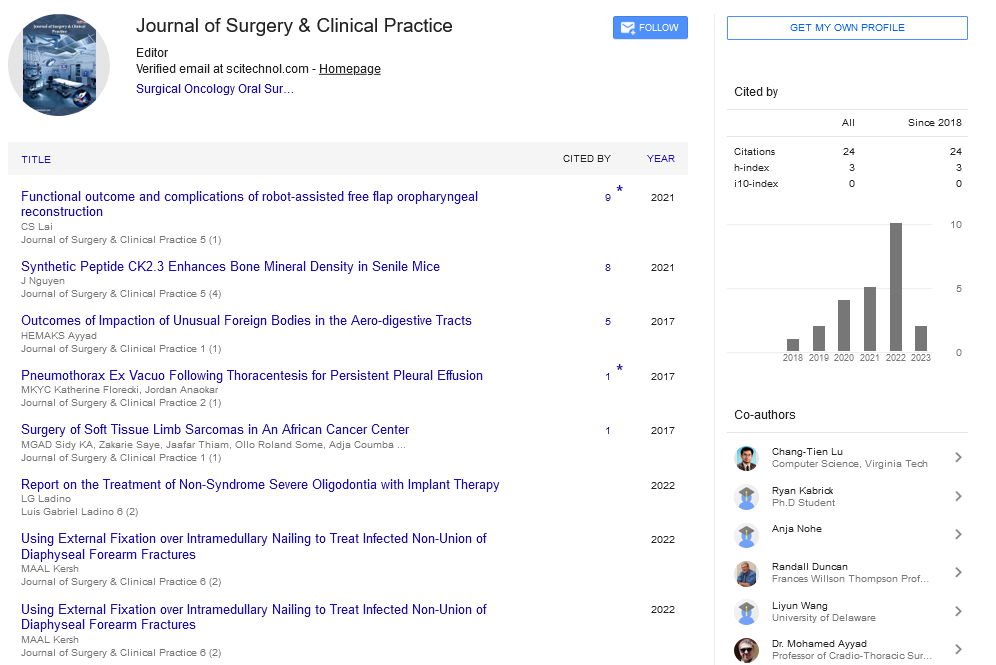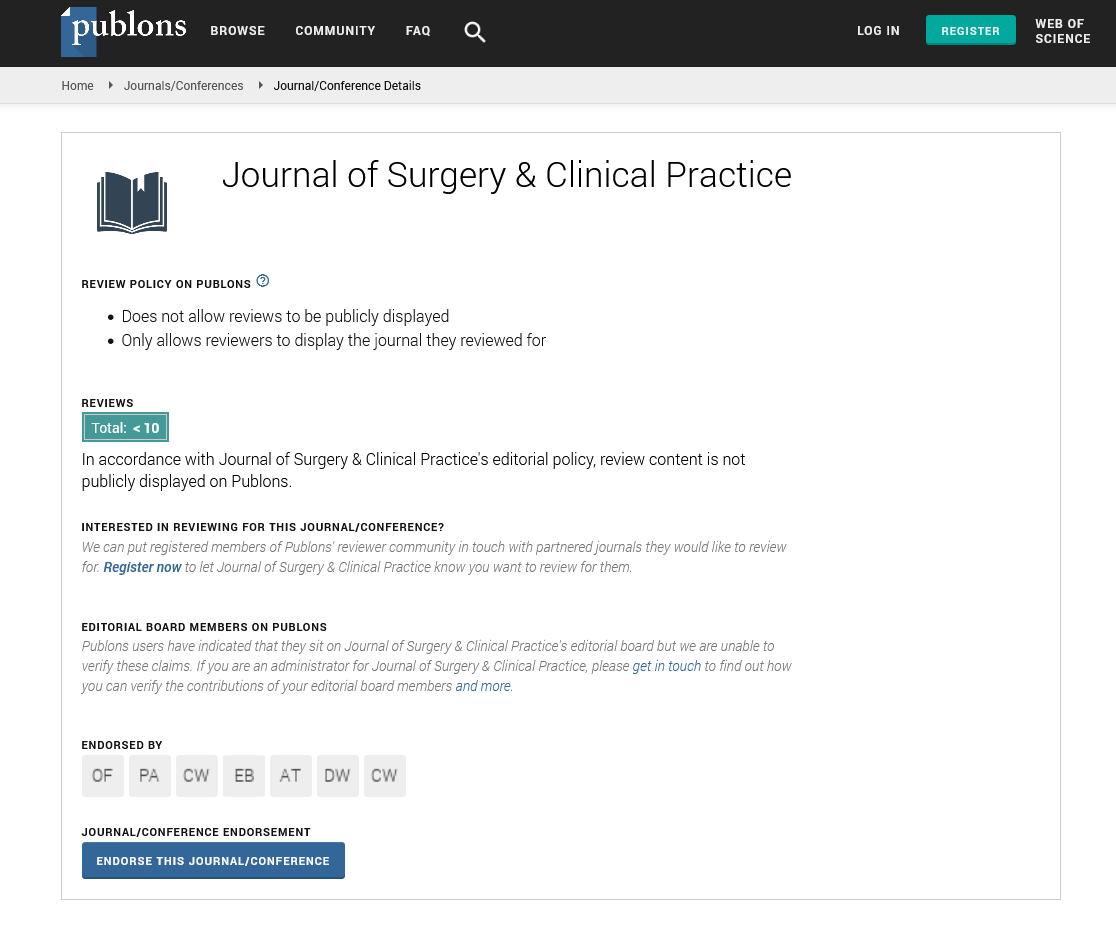Case Report, J Surg Clin Pract Vol: 3 Issue: 1
Rare Case of an Adrenal Tumor: Phaeochromocytoma with Concomitant Hypercortisolism
Man Hon Tang1*, Clement LK Chia1, Vikram Janardan Sonawane2, Kuttiparambil Unnikrishnan3 and Reyaz Moiz Singaporewalla1
1Department of General Surgery, Khoo Teck Puat Hospital, Singapore
2Department of General Medicine, Khoo Teck Puat Hospital, Singapore
3Department of Pathology, National University Hospital, Singapore
*Corresponding Author : Man Hon Tang
Department of General Surgery, Khoo Teck Puat Hospital, Singapore
Tel: 65-6555 8000
E-mail: Manhon.tang@mohh.com.sg
Received: April 09, 2019 Accepted: June 12, 2019 Published: June 19, 2019
Citation: Tang MH, Chia CLK, Sonawane VJ, Unnikrishnan K, Singaporewalla RM (2019) Rare Case of an Adrenal Tumor: Phaeochromocytoma with Concomitant Hypercortisolism . J Surg Clin Pract 3:1.
Abstract
This case study represents a patient with an adrenal nodule with functional studies positive for phaeochromocytoma as well as hypercortisolism. We postulate that a catecholamine stress response from the phaeochromocytoma resulted in a hypercortisol secretion from the adrenal cortex.
Keywords: Pheochromocytoma; Adrenal gland neoplasms; Hypercortisolism
Introduction
Phaeochromocytoma are catecholamines secreting tumors of the adrenal gland. There are rare cases reported whereby phaeochromocytomas can co-secrete other substances such as serotonin, vasopressin, adrenocorticotrophic hormone (ACTH), somatostatin and neuropeptide.
Case Report
HMH is a 41-year-old female with a past medical history of hypertension, currently on a single anti-hypertensive medication (Nifedipine LA) as well as newly diagnosed diabetes mellitus. She presented to the emergency department for palpitations and tremors with abdominal discomfort. She was tachycardic with a heart rate of 100 beats per minute and a blood pressure of 180/80. Initial laboratory investigations were largely normal. ECG revealed sinus tachycardia. Physical examination was otherwise unremarkable, with no obvious stigmata of Cushing’s Syndrome. A Computed Tomography (CT) scan of the abdomen and pelvis was performed which showed a right adrenal nodule measuring 2.5 by 3.5 cm (Figure 1). Dedicated CT of the adrenal glands showed that to be a slightly hyperdense lesion at 40 Hounsfield Units (HU) and enhances to 52 HU with contrast with minimal washout (5%). There were no other features of malignancy. Workup for functional status of the adrenal nodule was performed (Table 1).
| Hormonal workup (range) | Pre-op | Post-op |
|---|---|---|
| Fasting blood glucose (4.0-6.0mmol/L) | 17.5 | 5.6 |
| Glycosylated HbA1C (4.5-6.4%) | 8.3 | 6.8 |
| 24-hr urinary cortisol (100-379 nmol/day) | 3741 | 328 |
| ACTH level (1.6-13.0 pmol/L) | 3.8 | 7.7 |
| High dose DST (133-537 nmol/L) | 854 | - |
| Adrenaline (3-109 nmol/day) | 1392 | <21 |
| Metanephrine (325-1530 nmol/day) | 9496 | <50 |
| Noradrenaline (89-473 nmol/day) | 7081 | 416 |
| Normetanephrine (885-2880 nmol/day) | 20626 | 2264 |
Table 1: Functional workup of right adrenal nodule.
Initial functional studies showed it to be likely an adrenocorticol tumor with excessive primary cortisol secretion with normal ACTH levels and she was being worked up for subsequent surgical resection. Results of the urine screen for phaeochromocytoma took a longer time to process (approximately 2 weeks), which was positive as well, much to the surprise of the surgical team. As such, pre-operative optimization was performed for both Phaeochromocytoma and Cushing’s Syndrome. Alpha-blocker (Prazocin) was started preoperatively and up-titrated to achieve a systolic BP of less than 160. After her BP was satisfactorily controlled, she was also started on beta-blocker. Prior to surgery, she was kept on intra-venous hydration and intra-venous steroids commenced. She underwent an uneventful laparoscopic adrenalectomy with intra-operative blood pressure rising to above 200 systolic during manipulation of the adrenal gland which was controlled with short acting beta-blockers (Labetalol). Her post-operative stay was unremarkable and she was discharged on post-operative day 2.
Histology showed a benign 3.2 cm tumor in the adrenal medulla that stained positive for phaeochromocytoma. There were no atypical features. There was also a compressed rim of adrenal cortex tissue but there was no evidence of a corticomedullary mixed tumor. ACTH immuno-staining of the tumor was negative (Figure 2). While Cortico-Releasing Hormone (CRH) staining would be ideal to obtain confirmation that the phaeochromocytoma causes ectopic CRH production, this stain was unfortunately not available locally.
Figure 2: Histological slides showing (a) H&E staining at low power view of the tumour composed of nested aggregates of tumour cells with interspersed slender vessels and at high power view, the individual tumour cells show round eccentric nuclei with mild to moderate pleomorphism and rare mitotic figures (<1/10hpf). (b) The tumour is located within the medulla, expanding and compressing the overlying cortex but there is no definite infiltration beyond the pseudocapsule of the tumour, with a compressed rim of adrenal parenchyma is seen at the periphery. (c) This highlights the absence of expression of ACTH by the tumour cells on immunohistochemistry. Additional immunohistochemistry showed no expression for Alpha-inhibin, melan A and calretinin, hence ruling out the possibility of an adrenocortical origin for the tumour. (d) The tumour cells show diffuse string cytoplasmic expression of Synaptophysin and Chromogranin on immunohistochemistry. The interpsersed sustentacular cells are also highlighted by S-100 expression on immunohistochemistry.
Her symptoms and diabetic control have improved. Repeat tests showed resolution of her phaeochromocytoma as well as her hypercortisolism (Table 1). This case highlights that adrenal nodules can rarely co-secretes multiple functional substances and thorough investigations is required before surgery.
Discussion
Patient with concomitant Phaeochromocytoma and Cushing’s syndrome is rare and is usually mediated via ectopic ACTH production [1]. There are rare cases reported whereby phaeochromocytomas can co-secrete other substances such as seretonin, vasopressin, ACTH, somatostatin and other neuropeptides. Ectopic CRH production by these tumours has also been reported [2,3]. In other cases, the hypercortisolism has been due to mixed cortico-medullary or adrenal collision tumours [4]. Although the adrenal cortex and medulla are considered distinct functional systems, there seem to be some interactions between them though the exact mechanism remains unclear. While it is well-established the effects of corticosteroids on catecholamine synthesis and release, the influence of adrenal medullary hormones on cortical function is less clear.
Immunostaining and ultrastructural studies have shown extensive intermingling of cortical and medullary cells within the adrenal gland [5]. The adrenal medulla also secretes multiple peptides, which can stimulate adrenocortical steroid production such as VIP, vasopressin and oxytocin, neuropeptide Y, substance P, neuromedin-N and serotonin [6]. In addition, cytokines such as interleukin-6 that can stimulate CRH and ACTH production as well as glucocorticoid secretion from the adrenal cortex are also released from the medulla [7]. In animal models, perfusion of porcine adrenals with catecholamines has been reported to release corticosteroids [8]. Another theory in which the medulla can have an effect on the cortex is the distortion of the normal adrenal architecture by the phaeochromocytoma may have resulted in loss of paracrine or autocrine regulation thus allowing catecholamine-stimulated adrenocortical activity to proceed.
In this patient, the normal ACTH levels excluded the possibility of an ectopic ACTH secreting source and absence of positive ACTH immunostaining in this patient suggest that the phaeochromocytoma did not secrete ACTH. While CRH secretion by phaeochromocytomas has been described, these tumours usually show positive immunostaining for ACTH and serum ACTH levels are elevated. While the mechanism in which a phaeochromocytoma can affect the adrenal cortical function is unclear, this process is likely complex and multi-factorial with many hormones and regulatory mechanisms in play. A Francophone observational study of 16 cases of ectopic hormone secreting phaeochromocytoma found that these cases were neither familial nor malignant, it is likely that the catecholamine stress response resulted in raised cortisol levels. The cell receptors for these hormones are linked and their response to cortisol down-regulated, possibly leading to a kind of paraneoplastic elevation in cortisol [9]. We postulate that this is the likely mechanism of action in our case as well.
Conclusion
This rare case study shows that a phoechromocytoma has the potential to influence the cortisol hormonal axis. It is important to be aware of this entity and optimize the patient appropriately perioperatively.
References
- Reddy MP, Rao DMR, Verma RS, Srinath B, Katiyar RS (1998) Response of S13 mulberry variety to VAM inoculation under semi-arid condition. Ind J Plant Physiol 3: 194-196.
- Bloemberg GV, Wijfjes AHM, Lamers GEM, Stuurmam N, Lugtenberg BJJ (2000) Simultaneous imaging of pseudomonas fluoresens WCS 3655 populations expressing three different autofluorescent proteins in the rhizosphere: new perspective for studying microbial communities. Mol Plant Mic Int 13:1170-1176.
- Goel AK, Laura RD, Pathak DV, Anuradha G, Goel A (1999) Use of biofertilizers: potential, constraints and future strategies review. Int J Trop Agric 17: 1-18.
 Spanish
Spanish  Chinese
Chinese  Russian
Russian  German
German  French
French  Japanese
Japanese  Portuguese
Portuguese  Hindi
Hindi 


